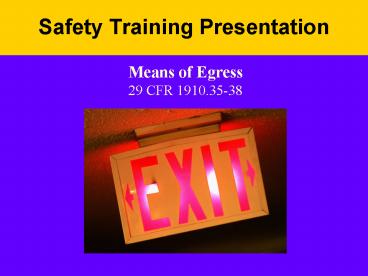Safety Training Presentation - PowerPoint PPT Presentation
1 / 27
Title:
Safety Training Presentation
Description:
Exit routes must be remote from each other. If one exit route is blocked, the other ... Example: police siren and flashing white lights. 9. ... – PowerPoint PPT presentation
Number of Views:24
Avg rating:3.0/5.0
Title: Safety Training Presentation
1
Safety Training Presentation
- Means of Egress29 CFR 1910.35-38
2
Means of Egress
- Continuous and unobstructed way of exit travel
from any point in a building or structure to a
public way - Consists of three parts
- the way of exit access
- the exit
- the way of exit discharge
3
Number of Exit Routes
- Number of employees
- Size of building
- Arrangement of workplace
- Building occupancy
4
Location of Exit Routes
- Minimum of two exit routes
- Exit routes must be remote from each other
- If one exit route is blocked, the other is
available - Single exit is allowed in rare cases
5
Size of Exit Routes
- Large enough for maximum occupant load for each
floor - Capacity does not decrease at any point
- Minimum of 6 feet 8 inches high
- At least 28 inches wide
6
Unobstructed Access
- Maintain exit routes free of obstructions
- Exit route cannot require travel to a dead end
- Exit route cannot go through a room that might
be locked
7
Minimize Danger
- No explosive or flammable items
- No materials that burn quickly
- No materials that emit poisonous fumes when
burned
8
Marking Exits
- Clearly visible sign reading EXIT
- Exit sign in distinctive color
- Signs indicating direction to nearest exit
- No obstructions or decorations
9
Nonexit Doors
- Any doorway or passage that might be mistaken
for an exit - Mark with NOT AN EXIT
- Mark doors to indicate actual use
10
Adequate Lighting
- Exit routes illuminated
- Exit signs illuminated or made of reflective
material - Self-lighting signs maintained
- No brightly lit objects near exit sign
11
Outdoor Exit Routes
- Balcony, porch, roof
- Guardrails to protect unenclosed sides
- Covered if snow/ice likely to accumulate
- Straight with level floor
- No dead ends that branch off exit route
12
Doors Readily Open
- Doors open from the inside
- No keys, tools, or special knowledge required
- Free of device that could restrict emergency use
13
Exit Route Leads Outside
- Directly outside to a street or walkway
- To an open space with access to the outside
- Clearly show how to leave the building
- Paths barricaded along exit route that lead
elsewhere
14
Emergency Action Plan
- Escape routes
- Alarm systems
- Evacuation procedures
- Training
15
Alarm Systems
- Distinctive signal that warns employees of
emergencies - Noticeable above surrounding noise and lights
- Alarm heard/seen in entire facility
- Manual actuation devices
- Backup alarm systems
16
Sounding Alarm Procedures
- Manual pull box alarm
- Public address system
- Phones or radios
- Air horns
- Yell for help
17
Test Alarm Systems
- At least every two months
- Annually for monitored systems
- To ensure reliability
- To ensure adequacy
18
Emergency Numbers
- Post near phones
- Post on employee notification boards
- Post in supervisors offices
- Include fire, police, hospital
- Include emergency response personnel
19
Evacuation Assignments
- Evacuation coordinators
- Head count
- First aid and CPR
- Equipment shutdown
- Fire responders
- Evacuation of employees who need assistance
20
Evacuation Procedures
- Recognize the evacuation signal
- Listen for instructions
- Shut down equipment
- Follow the nearest exit route
- Proceed to the assembly area
21
Employee Training
- Location of evacuation routes
- Alarm signals
- Assembly areas
- Evacuation assignments
- Drills
22
Exits at Home
- Determine exits
- Develop evacuation plan
- Train your family
- Know the location of exits in public places
23
Summary
- Know the location of your exit routes
- Keep exit routes clear of obstructions
- Keep exit signs clearly visible
- Recognize alarm signals
- Take evacuation drills seriously
24
Quiz
- 1. Describe the exit route that is nearest to
your normal workstation. - 2. Describe an alternate exit route from your
normal workstation. - 3. Name some items that you have seen
obstructing exit routes. - 4. Signs along the exit route only need to say
EXIT. True or False - 5. Some doors might be mistaken for an exit how
should those doors be marked?
25
Quiz (cont.)
- 6. Exit doors cannot be locked from the
inside. True or False - 7. Once you exit the building, where should you
go? - 8. Describe what the emergency alarm in your
building looks and sounds like. - 9. Describe how you would sound the alarm in
your building if you discovered a fire. - 10. What is the minimum number of exit routes for
any work area?
26
Quiz Answers
- 1. Various answers, depending on location of
workstation - 2. Various answers, depending on location of
workstation - 3. Various answers file cabinets, storage boxes,
janitorial supplies, old furniture, etc. - 4. False the signs also need to point to the
direction of the exit. - 5. NOT AN EXIT
27
Quiz Answers (cont.)
- 6. True
- 7. Go to the designated assembly area.
- 8. Example police siren and flashing white
lights - 9. Manual pull box, PA system, phone, air horn,
yelling - 10. Two exit routes that are remote from each
other































